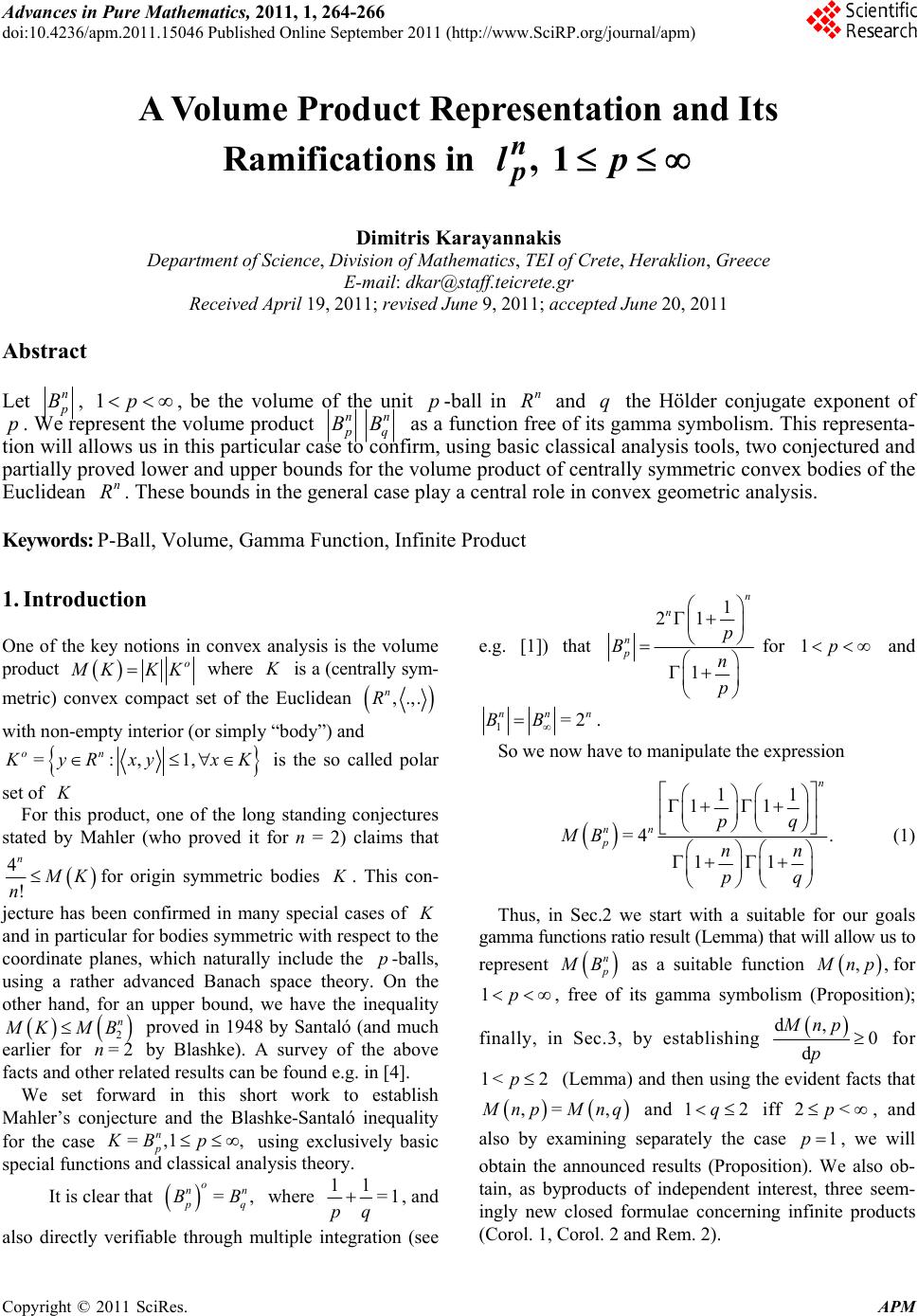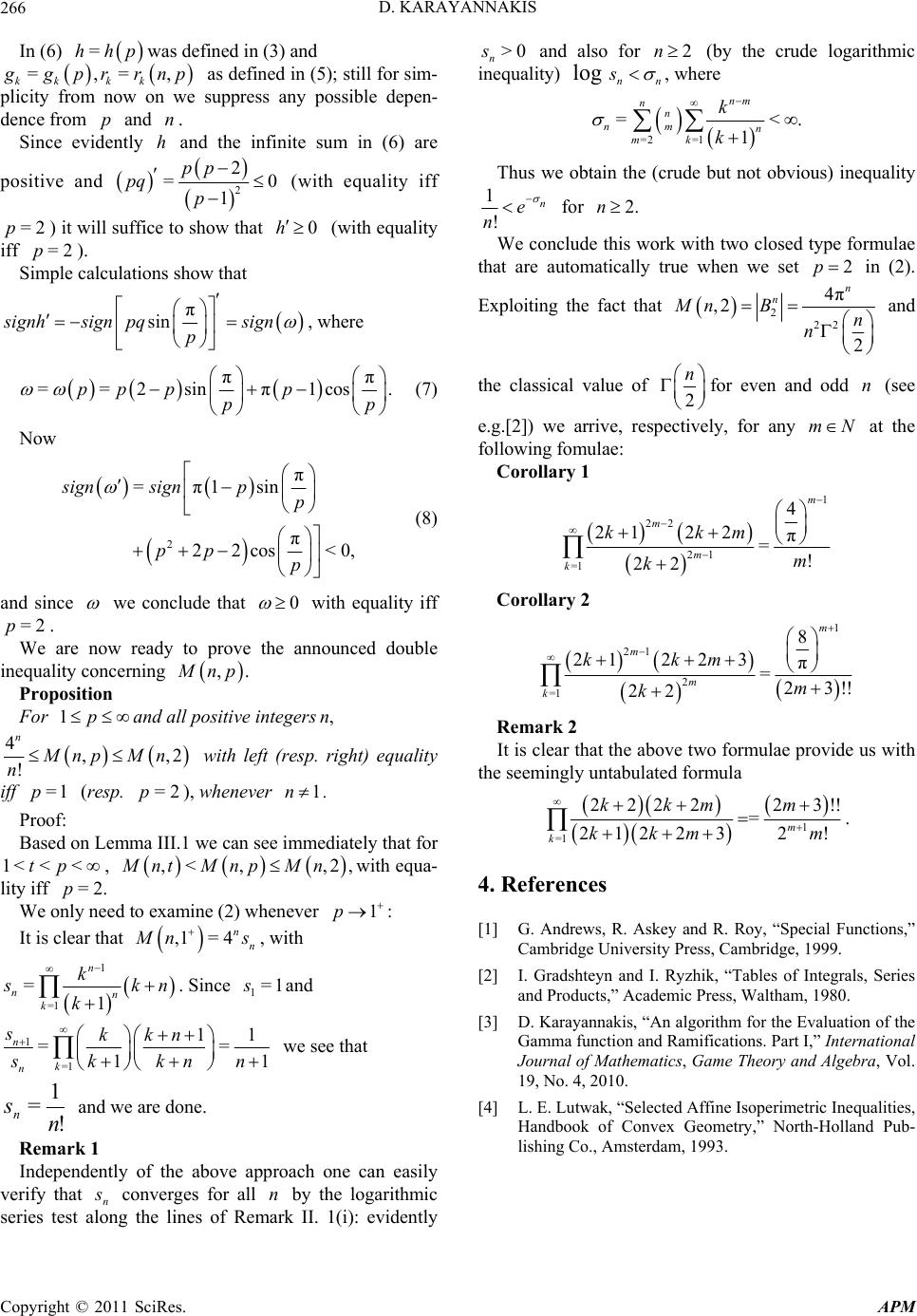Paper Menu >>
Journal Menu >>
 Advances in Pure Mathematics, 2011, 1, 264-266 doi:10.4236/apm.2011.15046 Published Online September 2011 (http://www.SciRP.org/journal/apm) Copyright © 2011 SciRes. APM A Volume Product Representation and Its Ramifications in ,1 n p lp Dimitris Karayannakis Department of Sci ence , Division of Mathematics, TEI of Crete, Heraklion, Greece E-mail: dkar@staff.teicrete.gr Received April 19, 2011; revised June 9, 2011; accepted June 20, 2011 Abstract Let n p B , , be the volume of the unit 1p p -ball in n R and q the Hölder conjugate exponent of p . We represent the volume product n p B n q B as a function free of its gamma symbolism. This representa- tion will allows us in this particular case to confirm, using basic classical analysis tools, two conjectured and partially proved lower and upper bounds for the volume product of centrally symmetric convex bodies of the Euclidean n R . These bounds in the general case play a central role in convex geometric analysis. Keywords: P-Ball, Volume, Gamma Function, Infinite Product 1. Introduction One of the key notions in convex analysis is the volume product o M KKK where K is a (centrally sym- metric) convex compact set of the Euclidean ,.,. n R with non-empty interior (or simply “body”) and =:,1, on K yR xyxK is the so called polar set of K For this product, one of the long standing conjectures stated by Mahler (who proved it for n = 2) claims that 4 ! n M K nfor origin symmetric bodies . This con- K jecture has been confirmed in many special cases of K and in particular for bodies symmetric with respect to the coordinate planes, which naturally include the -balls, using a rather advanced Banach space theory. On the other hand, for an upper bound, we have the inequality p 2 n M KMB =2n proved in 1948 by Santaló (and much earlier for by Blashke). A survey of the above facts and other related results can be found e.g. in [4]. We set forward in this short work to establish Mahler’s conjecture and the Blashke-Santaló inequality for the case using exclusively basic special functions and classical analysis theory. =,1 n p KB p, n It is clear that =, o n p q BB where 11 =1 pq , and also directly verifiable through multiple integration (see e.g. [1]) that 1 21 1 n n n p p Bn p for and 1p 1=2 nn BB n . So we now have to manipulate the expression 11 11 =4 . 11 n nn p pq MB nn pq (1) Thus, in Sec.2 we start with a suitable for our goals gamma functions ratio result (Lemma) that will allow us to represent n p M B as a suitable function ,, M np for 1p , free of its gamma symbolism (Proposition); finally, in Sec.3, by establishing d, 0 d Mnp p for 1< 2p (Lemma) and then using the evident facts that ,,= M npM nq and 1 iff , and also by examining separately the case , we will 2q 2<p 1p obtain the announced results (Proposition). We also ob- tain, as byproducts of independent interest, three seem- ingly new closed formulae concerning infinite products (Corol. 1, Corol. 2 and Rem. 2).  D. KARAYANNAKIS 265 2. A Lemma and a Proposition Lemma For and >0x0< 1 we have that =1 1 1= 1 k xkkx xkkx . (2) Proof: Let ,Px be the infinite product in lemma’s statement .One of the classical definitions for the gamma function for any complex , is 0, 1,2,z 1! =, lim z kk kk zz where is the shifted factorial .Substituting in the above limit, respectively, k z 1 zzz k =1 1 , =,zzx and = z x, and after simplifying we arrive at ! 1= lim 1 k kkk kx x xx which is iden- tical to ,Px . Remark 1) Independently of the above argumentation we can easily check that ,Px exists as a two-variable func- ction over since evidently 0,10, 0,Px 0 and, by use of the inequality , log1, >tt t =1 log , 1 1 1 k Px xkkx < . 2) This lemma was proved formally (and from “scratch”) in [3] where the scheme of the proof served different purposes concerning the numerical evaluation of the gamma function. Proposition For , 1< <p 2 2 22 22 22 =1 ,= 1 4(1) n n nn k Mnp n knk kk pq pq hp k (3) where π =π sin hp pq p . Proof: Evidently and so (2) is trivially true for . Thus we can consider (1)= 1h =1n2.n At first let us rewrite (1) as 21 11 41 , n n n pq Mnp nnn pq pq Based on Lemma II.1 for 1 =p and =,=1,, 1 m x mn p we see that 1 1 =1 1 1 =, 1 n nm p nn P pp q m p (4) where ,Px was defined above in Lemma Working in a similar way we obtain the “conjugate expression” .nq We observe now that 2 2 =1 11 ,, 1, 1 =11 k kkk nm nm PP pp qq krnmp nm pqn mgprn mp , (5) where we have set 2 2 ,= kj rjp kjkpq and =1, kk g pr p. Combining (2), (4), and (5), and by “telescoping”, we obtain (3). 3. One More Lemma and a Conclusive Proposition Lemma Let 1p2 . Then d, 0 d Mnp p for all n with equality iff for =2p1n . Proof: 1,= 4n Mp p and once more we can consider By straightforward differentiation with respect to and in the case of the infinite product of (2) by logari- thmic differentiation (noticing that this product by con- struction is a real analytic function of having as logarithm a uniformly converging series of differentiable functions of ) we obtain 2.np p 2 =1 d(,) d 12 =22 kkk Mnp sign p nn sign nhh pqg r . (6) Copyright © 2011 SciRes. APM  D. KARAYANNAKIS Copyright © 2011 SciRes. APM 266 In (6) was defined in (3) and k =hhp =,= k , kk g gpr r p np n as defined in (5); still for sim- plicity from now on we suppress any possible depen- dence from and . Since evidently and the infinite sum in (6) are h positive and 2 2 = 1 pp pq p 0 (with equality iff =2pp) it will suffice to show that (with equality iff ). 0h =2 Simple calculations show that π sinsignhsign pqsign p , where π ==2sin π1cos .pp pp pp π (7) Now 2 π =π1sin π 22cos< 0, signsignp p pp p (8) and since we conclude that 0 with equality iff . =2p We are now ready to prove the announced double inequality concerning ,. M np Proposition For and all positive integers 1p ,n 4, ! nMnp Mn n , 2 with left (resp. right) equality iff (resp. ), whenever . =1p=2p1n Proof: Based on Lemma III.1 we can see immediately that for , with equa- lity iff 1< <<tp =2.p ,< ,,2,MntMnp Mn p We only need to examine (2) whenever 1 : It is clear that ,1= 4nn M n s, with 1 =1 = 1 n nn k k s kn1 s k . Since and =1 1 =1 == n k n skkn11 11 s kkn n we see that ! 1 =n sn and we are done. Remark 1 Independently of the above approach one can easily verify that n s converges for all by the logarithmic series test along the lines of Remark II. 1(i): evidently and also for (by the crude logarithmic inequality) n >0 n s2n n log n s , where =2 =1 n nm mk =<. 1 nm n k k n Thus we obtain the (crude but not obvious) inequality 1 ! n e n for 2.n We conclude this work with two closed type formulae that are automatically true when we set 2p in (2). Exploiting the fact that 2 22 4π ,2 2 n n Bn n Mn and the classical value of 2 n for even and odd (see n e.g.[2]) we arrive, respectively, for any at the following fomulae: mN Corollary 1 1 22 21 m k 21 4 22π =! 22 m m kkm m =1 k Corollary 2 1 21 22 m k 2 =1 8 223π =23!! m m k kkm m 21 Remark 2 It is clear that the above two formulae provide us with the seemingly untabulated formula 1 =1 22 212 kk kk 2223!! = 2 32! m k m m m m . 4. References [1] G. Andrews, R. Askey and R. Roy, “Special Functions,” Cambridge University Press, Cambridge, 1999. [2] I. Gradshteyn and I. Ryzhik, “Tables of Integrals, Series and Products,” Academic Press, Waltham, 1980. [3] D. Karayannakis, “An algorithm for the Evaluation of the Gamma function and Ramifications. Part I,” International Journal of Mathematics, Game Theory and Algebra, Vol. 19, No. 4, 2010. [4] L. E. Lutwak, “Selected Affine Isoperimetric Inequalities, Handbook of Convex Geometry,” North-Holland Pub- lishing Co., Amsterdam, 1993. |

